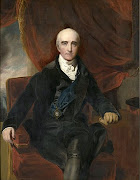So, first of all these are not REAL ghosts, but rather former inhabitants of Dangan Castle.
Our Allen and Sweeney ancestors who lived on the perimeter of the great estate would have known OF these people, and perhaps acted as groundskeepers or servants to the estate. We know that the Sweeney's acted as nurserymen in the area, so they may have worked on the grounds. We know that the Allen's had experience with horses; Frank Allen was said to have raised race horses on his farm. It is possible they worked in the stables for the gentry. Who knows? We of course have no records that far back, other than they live on and farmed pieces of land connecting to the estate. The Wellesley family ended up in debt, selling the now ruined estate at Dangan to Colonel Burrows, who then leased it to Mr. O'Conner.
Who lived at Dangan Castle?
The inhabitants of Dangan Castle were an illustrious family indeed.
Forfeited lands at Dangan after the battle of Dungan Hill in 1652 included lands owned by Catholics Robert Rochfort, Garrot Smith, and Valerian Wesley.
Garret Wesley- forfeited lands after the battle of Dungan Hill- so- how did he get them back? They became Protestants. Valerian Wesley owned 380 acres at Dangan in 1654.
Garret Wesley- circa 1665- died 1728- Represented Trim and County Meath in the Irish Parliament. Had no children and left Dangan to his cousin, Richard Colley.
Richard Colley Wesley, 1st Baron Mornington- born around 1690 as Richard Colley, inherited the estates of Dangan and Mornington in County Meath from his cousin, Garret Wesley, in 1728, changing his name. Represented Trim in the Irish House of Commons from 1729-1746, High Sheriff of Meath in 1734, became Baron Mornington in 1746. He was described as an eccentric, good-natured country gentleman. He was also extravagant and died in debt, resulting in his grandson Richard selling Dangan Estate 40 years after his death.
Garret Colley Wesley, 1st Earl of Mornington
 |
| Garret Wesley, 1st Earl of Mornington 1735-1781 |
Garret Wesley was born at Dangan Castle was a musician who excelled in the violin from his early childhood and later became a composer. It was said that Dangan Castle had two organs- one in the hall and one in the chapel, and a harpsichord in the breakfast room. He attended Trinity College in Dublin, becoming a professor of music in 1764. He represented Trim in the Irish House of Commons and succeeded his father in 1758. He married Anne Hill-Trevor in 1759 and had nine children, many of whom made their marks in history. Unfortunately he was careless with money, leaving the family in financial ruin, forcing the decision to sell their Irish estates.
His children included:
Richard Colley Wellesley- born 1760 Dangan Castle, attended Harrow, Eton, and Oxford, represented Trim in the Irish House of Commons in 1780 then inherited his father's title of 2nd Earl of Mornington in 1781, taking a seat in the Irish House of Lords. Due to the extravagances of his father and grandfather he was heavily in debt and most of his Irish estates were sold. He served as Lord Lieutenant in Ireland and was Governor General of India from 1798-1805.
 |
| Richard Wellesley 1760-1842 |
3- William Wellesley-Pole, 3rd Earl of Mornington- born 20 May 1763, Dangan Castle. William was educated at Eton and then entered the Royal Navy. He represented Trim in the Irish Parliament from 1783-1790. He became 3rd Earl of Mornington in 1842 after the death of his elder brother Richard.
,_by_Benjamin_West_(1738-1820).jpg) |
| William Wellesley, aged 14, 1777- painting by Benjamin West |
Arthur Wellesley, 1st Duke of Wellington- born 1 May 1769, Dublin, raised at Dangan Castle. He was educated at the diocesan school in Trim before furthering his education including attending Eton. One of the leading military and political leaders in Britain, one of the commanders who defeated Napoleon at the Battle of Waterloo in 1815, twice prime minister of the United Kingdom.
Gerald Valerian Wesley, the fifth son of Garret Wesley, the 1st Earl of Mornington, was born at Dangan Castle on 7 December 1770. He graduated with a Doctor of Divinity. He was "prebendary" (canon) of Durham Cathedral and Chaplain to the British Royal Household. He is buried at Durham Cathedral in England.
 |
| Rev. Hon. Gerald Valerian Wesley |
These boys played briefly in the halls of Dangan Castle, and around its grounds, getting their earliest education before being sent to school in Trim, then Dublin or England. For our ancestors, they might as well have been living on another planet. Their elevated means was beyond the imagination of the Irish Catholic tenants, who had only brief glimpses of the extravagances of that way of life.



